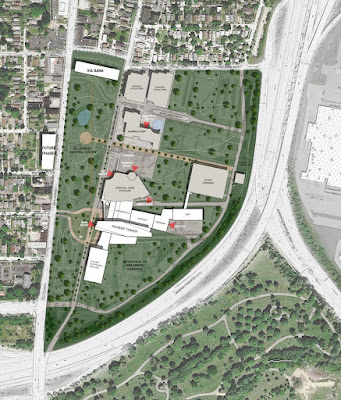After many years of false starts and litigation, a large vacant parcel at the north end of Little Italy is back in play for a new real estate development.
Property owner University Circle Inc. has selected a partnership of Property Advisors Group of Beachwood and M. Panzica Development of Cleveland to develop what is called the Woodhill Supply site. The vacant 2.14-acre property is located in the 1800 block of East 123rd Street and Coltman Road.
Preliminary illustrations of the partnership's vision for the site were submitted earlier this week to the city of Cleveland's Building Department for a zoning review. The zoning review will reveal what, if any, variances may be needed prior to securing a building permit from the city.
Plans also have to be approved by the local design-review committee and the city's Landmarks Commission as Little Italy is an historic district. GLSD Architects, LLC, a Geis Companies affiliate, is the project's designer.
Early planning drafts show a 114-unit housing development offering a mix of for-sale and rental units. It includes an L-shaped, 105-unit Woodhill Apartments building along East 123rd next to Lakeview Cemetery plus two new streets, both linking East 123rd and Coltman and proposed new parking lots adding about 105 spaces.
 |
| The Woodhill Supply site is the location of the proposed Panzica- Property Advisors Group development (Cuyahoga County). |
The roughly 98,000-square-foot apartment building is proposed to be mostly four stories tall with a section at the northeast corner, away from existing housing, standing five stories. Also proposed is a row of nine, three-story-tall, for-sale townhouses along Coltman. The townhomes would have their own garages on the ground-floor of each unit and accessed from behind.
Plans show the apartment building with a ground-floor lobby, on-site management/leasing office, gym, two parcel rooms, as well as a meeting room with kitchen. Outdoor grassy areas include tables and benches plus a play area for children. Those plans are being studied by the neighborhood's design-review committee.
"We're working through the preliminary design discussions with the stakeholders," said development principal Mike Panzica. "Still premature to discuss in detail."
UCI President Chris Ronayne also said it was premature to discuss the proposed project.
This would be the second Little Italy endeavor by the partnership of M. Panzica Development and Property Advisors Group. Their first, Baricelli Inn Apartments, is under construction on Cornell Road next to the historic Baricelli Inn, an 1896-built stone mansion that was previously the Washington Place Bistro & Inn. The new-build apartment building will have 44 housing units while the historic inn will be converted into a dozen apartments.
 |
| An early draft from last fall of what the for-sale townhomes along Coltman Road could look like, and how they could screen views of the apartment building from some nearby homes (contributed). |
For UCI, it's their second potential asset disposition this year to a developer seeking to inject new residential life into an underutilized property. At Ford Drive and Hessler Road, developers Rick Maron and Russell Berusch want to renovate two historic buildings with nine apartments and add behind them a new building with 23 micro-unit apartments.
Since UCI isn't a governmental agency, it isn't subject to public bidding requirements. Instead, for each asset disposition, UCI sent requests for information to several developers to solicit responses from them. The responses were reviewed by UCI's Development Committee.
At a Feb. 10 community meeting on the Ford-Hessler development, UCI's Vice President of Community Development Debbie Berry said UCI was looking for particular developers. Specifically, they were looking for developers that had the capacity to deliver projects and had experience in working in the community development organization's service area.
The Little Italy site became available after Woodhill Supply Inc., a distributor of kitchen and bath materials, moved out of the neighborhood in 2010 for locations in Cleveland and Willoughby.
In 2005, Woodhill Supply President Arnold Kaufman and salesman Michael Semlar were convicted of their involvement in a Cleveland Water Division corruption case and sentenced to prison. The vacated buildings caught fire in 2015 and their heavily damaged remnants were demolished. No documents regarding cause of the fire were immediately available.
 |
| Preliminary site plan showing a redevelopment concept for the Woodhill Supply site in Little Italy (GLSD). |
In 2014, Visconsi Companies Ltd. of Pepper Pike proposed a 205-unit apartment complex featuring two buildings, each six stories tall. One would have been along Coltman and the other along East 123rd. Between them was to be a two-level parking garage with the first level below ground and the second level topped by a green roof.
Although the project was approved by the Landmarks Commission and granted variances by the Board of Zoning Appeals, a neighbor of the development site filed multiple legal challenges over several years against the city, its zoning administrator and then-property owner East 123 St. Properties, Ltd. for approving the project.
Despite his legal defeats and mostly unsuccessful appeals, the resident wore down Visconsi which gave notice in March 2018 to the Eighth District Court of Appeals that it would no longer pursue its option to acquire the property. The resident promptly dropped the legal challenges.
In March 2019, UCI acquired the Woodhill Supply property for $1.975 million from East 123 St. Properties. The property is next to UCI's operations center and police department. However, UCI determined that disposing of the Woodhill Supply site for redevelopment offered its highest and best use.
Tyler Kapusta contributed to this article.






























